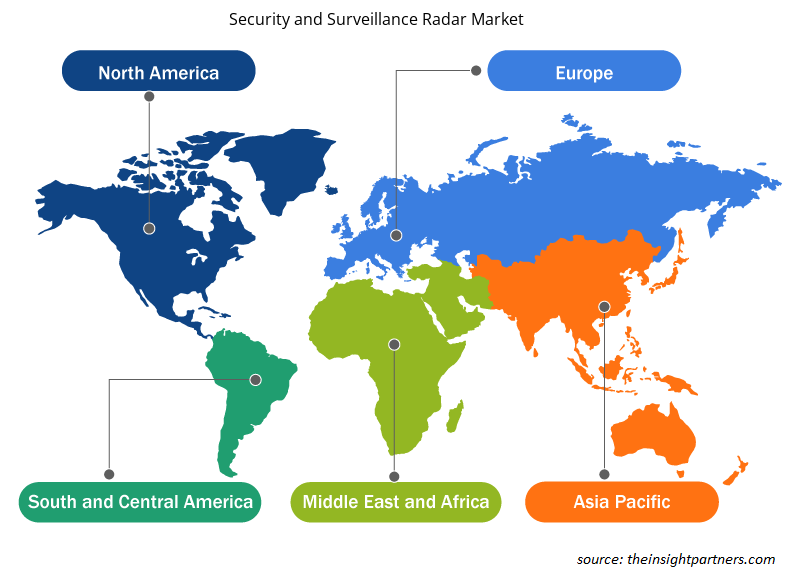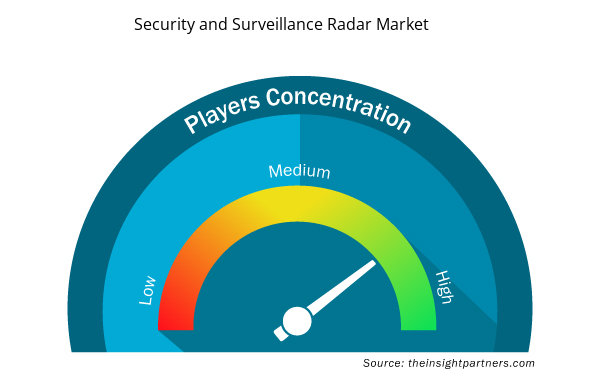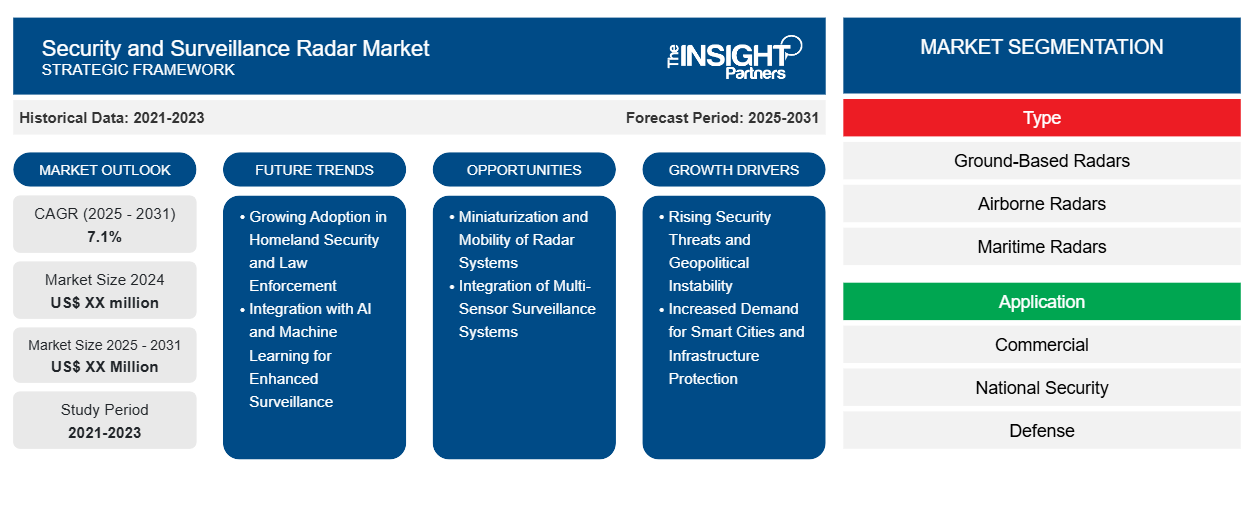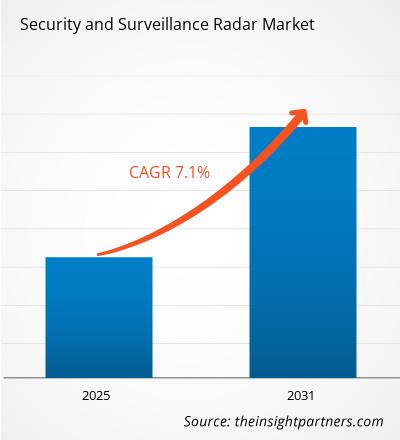من المتوقع أن يسجل سوق رادار الأمن والمراقبة معدل نمو سنوي مركب بنسبة 7.1٪ من عام 2023 إلى عام 2031، مع توسع حجم السوق من XX مليون دولار أمريكي في عام 2023 إلى XX مليون دولار أمريكي بحلول عام 2031.
تم تقسيم التقرير حسب النوع (الرادارات الأرضية، والرادارات المحمولة جواً، والرادارات البحرية)؛ والتطبيق (التجاري، والأمن الوطني، والدفاع). كما تم تقسيم التحليل العالمي إلى مستويات إقليمية ودول رئيسية. ويقدم التقرير القيمة بالدولار الأمريكي للتحليل والقطاعات المذكورة أعلاه.
غرض التقرير
يهدف تقرير سوق رادار الأمن والمراقبة الصادر عن The Insight Partners إلى وصف المشهد الحالي والنمو المستقبلي وأهم العوامل الدافعة والتحديات والفرص. سيوفر هذا رؤى لمختلف أصحاب المصلحة في الأعمال التجارية، مثل:
- مزودي/مصنعي التكنولوجيا: لفهم ديناميكيات السوق المتطورة ومعرفة فرص النمو المحتملة، وتمكينهم من اتخاذ قرارات استراتيجية مستنيرة.
- المستثمرون: إجراء تحليل شامل للاتجاهات فيما يتعلق بمعدل نمو السوق، وتوقعات السوق المالية، والفرص المتاحة عبر سلسلة القيمة.
- الهيئات التنظيمية: لتنظيم السياسات ومراقبة الأنشطة في السوق بهدف تقليل الانتهاكات والحفاظ على ثقة المستثمرين ودعم سلامة السوق واستقرارها.
تجزئة سوق رادار الأمن والمراقبة
يكتب
- الرادارات الأرضية
- الرادارات المحمولة جواً
- الرادارات البحرية
طلب
- تجاري
- الامن القومي
- الدفاع
قم بتخصيص هذا التقرير ليناسب متطلباتك
ستحصل على تخصيص لأي تقرير - مجانًا - بما في ذلك أجزاء من هذا التقرير، أو تحليل على مستوى الدولة، وحزمة بيانات Excel، بالإضافة إلى الاستفادة من العروض والخصومات الرائعة للشركات الناشئة والجامعات
- احصل على أهم اتجاهات السوق الرئيسية لهذا التقرير.ستتضمن هذه العينة المجانية تحليلاً للبيانات، بدءًا من اتجاهات السوق وحتى التقديرات والتوقعات.
عوامل نمو سوق رادار الأمن والمراقبة
- التهديدات الأمنية المتزايدة وعدم الاستقرار الجيوسياسي: أحد المحركات الأساسية لسوق رادار الأمن والمراقبة هو التكرار المتزايد للتهديدات الأمنية وعدم الاستقرار الجيوسياسي في جميع أنحاء العالم. لقد أدى الإرهاب والتمرد والحرب السيبرانية والصراعات الإقليمية إلى زيادة الطلب على أنظمة المراقبة القوية، وخاصة في المناطق الحساسة مثل أمن الحدود والمنشآت العسكرية والبنية التحتية الحيوية. تعد أنظمة الرادار ضرورية للكشف المبكر وتتبع ومراقبة التهديدات الجوية والبحرية والبرية، مما يسمح للسلطات بالاستجابة السريعة. أدت المخاوف الأمنية المتزايدة بسبب الصراعات عبر الحدود والإرهاب والتوترات العالمية إلى قيام الحكومات والمنظمات بالاستثمار بكثافة في أنظمة الرادار المتقدمة للدفاع الوطني وإنفاذ القانون والسلامة العامة.
- الطلب المتزايد على المدن الذكية وحماية البنية التحتية: إن صعود المدن الذكية والحاجة المتزايدة لحماية البنية التحتية الحيوية هو محرك مهم آخر. تُستخدم أنظمة الرادار الأمنية والمراقبة لحماية المطارات والموانئ البحرية ومحطات الطاقة والبنية التحتية الحيوية الأخرى من التهديدات المحتملة. مع زيادة عدد الأجهزة المتصلة في المدن الذكية والمناطق الحضرية، ارتفعت الحاجة إلى تقنيات المراقبة القادرة على مراقبة مناطق واسعة واكتشاف الاختراقات وضمان السلامة العامة. تعد أنظمة الرادار ضرورية لتوفير المراقبة على مدار الساعة طوال أيام الأسبوع، وخاصة في المناطق الحضرية حيث تتطلب الكثافة السكانية العالية والبنية التحتية مراقبة مستمرة للسلامة وإدارة المرور ومراقبة الأماكن العامة.
الاتجاهات المستقبلية لسوق رادار الأمن والمراقبة
- التبني المتزايد في مجال الأمن الداخلي وإنفاذ القانون: تستثمر وكالات الأمن الداخلي ومنظمات إنفاذ القانون بشكل متزايد في أنظمة الرادار لتعزيز قدراتها على المراقبة. تستخدم هذه الوكالات أنظمة الرادار لمهام مثل مراقبة الحدود، ومراقبة المناطق عالية الخطورة، وتتبع المركبات أو الأفراد المشتبه بهم. تعد رادار المراقبة الأرضية (GSR)، ورادار الأمن المحيطي، وأنظمة الرادار المثبتة على المركبات من بين الحلول التي تكتسب زخمًا في هذه القطاعات. يسمح تبني هذه الأنظمة لوكالات إنفاذ القانون بمراقبة مناطق شاسعة بشكل فعال والاستجابة بسرعة للأنشطة المشبوهة. يقدم الاتجاه المتزايد للاستثمار في التكنولوجيا من أجل السلامة العامة وجهود مكافحة الإرهاب فرصة كبيرة لمصنعي الرادار لتوسيع حصتهم في السوق في قطاعي الأمن الداخلي وإنفاذ القانون.
- التكامل مع الذكاء الاصطناعي والتعلم الآلي لتحسين المراقبة: يعد دمج أنظمة الرادار مع خوارزميات الذكاء الاصطناعي والتعلم الآلي من أكثر الفرص الواعدة في سوق رادارات الأمن والمراقبة. يمكن للذكاء الاصطناعي والتعلم الآلي تحسين معالجة بيانات الرادار بشكل كبير، مما يمكن الأنظمة من تحديد وتصنيف الأشياء تلقائيًا، واكتشاف السلوك غير المعتاد، والتنبؤ بالتهديدات المحتملة في الوقت الفعلي. يمكن أن يقلل هذا التكامل من عبء العمل على المشغلين البشريين ويحسن الاستجابة العامة لأنظمة المراقبة. بالإضافة إلى ذلك، يمكن لأنظمة الرادار التي تعمل بالذكاء الاصطناعي أن تعزز اكتشاف الشذوذ، مما يسمح باستجابات أسرع للتهديدات الناشئة، خاصة في البيئات المعقدة مثل المناطق الحضرية المزدحمة أو الحدود المفتوحة. هذه الفرصة ذات صلة خاصة في قطاعات مثل أمن الحدود والدفاع العسكري والسلامة العامة.
فرص سوق رادار الأمن والمراقبة
- التصغير والتنقل لأنظمة الرادار: أحد الاتجاهات الرئيسية في صناعة الرادار هو التصغير والتنقل لأنظمة الرادار. يتم تطوير أنظمة رادار أصغر وأخف وزناً بشكل متزايد للتطبيقات المحمولة والمركبة على المركبات والمحمولة جواً. غالبًا ما تكون هذه الأنظمة أكثر فعالية من حيث التكلفة وأسهل في النشر وتوفر مرونة أكبر في الاستخدام. إن الاتجاه نحو أنظمة الرادار المدمجة والمتنقلة يدفع النمو في تطبيقات مثل رادار الأمن المثبت على المركبات والطائرات بدون طيار وأنظمة الرادار المحمولة باليد التي يستخدمها أفراد إنفاذ القانون أو العسكريون. يسمح هذا الاتجاه بتبني أنظمة الرادار على نطاق أوسع في كل من الأسواق الدفاعية والمدنية، حيث تكون القدرة على التنقل والنشر السريع أمرًا بالغ الأهمية.
- دمج أنظمة المراقبة متعددة المستشعرات: هناك اتجاه ملحوظ آخر في سوق الرادار الأمني والمراقبي يتمثل في التكامل المتزايد لأنظمة المستشعرات المتعددة. يتم دمج أنظمة الرادار الحديثة بشكل متزايد مع أجهزة استشعار أخرى، مثل الكاميرات الحرارية وأجهزة الاستشعار بالأشعة تحت الحمراء والأجهزة الكهروضوئية وأجهزة الاستشعار الصوتية. يعمل هذا الاندماج متعدد المستشعرات على تحسين دقة وموثوقية المراقبة، حيث يمكن استكمال بيانات الرادار بمعلومات بصرية وحرارية للكشف عن التهديدات وتتبعها بشكل أفضل. تتيح القدرة على الجمع بين البيانات من أنواع مختلفة من أجهزة الاستشعار مراقبة أكثر شمولاً، خاصة في البيئات التي تحتاج إلى مراقبة أنواع مختلفة من التهديدات - المحمولة جواً وبرية وبحرية - في وقت واحد. هذا الاتجاه مهم بشكل خاص في أمن الحدود والمراقبة العسكرية وحماية البنية التحتية الحيوية.
رؤى إقليمية حول سوق رادار الأمن والمراقبة
لقد قام المحللون في Insight Partners بشرح الاتجاهات والعوامل الإقليمية المؤثرة على سوق رادار الأمن والمراقبة طوال فترة التوقعات بشكل شامل. يناقش هذا القسم أيضًا قطاعات سوق رادار الأمن والمراقبة والجغرافيا في جميع أنحاء أمريكا الشمالية وأوروبا ومنطقة آسيا والمحيط الهادئ والشرق الأوسط وأفريقيا وأمريكا الجنوبية والوسطى.

- احصل على البيانات الإقليمية المحددة لسوق رادار الأمن والمراقبة
نطاق تقرير سوق رادار الأمن والمراقبة
| سمة التقرير | تفاصيل |
|---|---|
| حجم السوق في عام 2023 | XX مليون دولار أمريكي |
| حجم السوق بحلول عام 2031 | XX مليون دولار أمريكي |
| معدل النمو السنوي المركب العالمي (2023 - 2031) | 7.1% |
| البيانات التاريخية | 2021-2022 |
| فترة التنبؤ | 2024-2031 |
| القطاعات المغطاة | حسب النوع
|
| المناطق والدول المغطاة | أمريكا الشمالية
|
| قادة السوق وملفات تعريف الشركات الرئيسية |
|
كثافة اللاعبين في سوق رادار الأمن والمراقبة: فهم تأثيرها على ديناميكيات الأعمال
يشهد سوق رادار الأمن والمراقبة نموًا سريعًا، مدفوعًا بالطلب المتزايد من المستخدم النهائي بسبب عوامل مثل تفضيلات المستهلكين المتطورة والتقدم التكنولوجي والوعي المتزايد بفوائد المنتج. ومع ارتفاع الطلب، تعمل الشركات على توسيع عروضها والابتكار لتلبية احتياجات المستهلكين والاستفادة من الاتجاهات الناشئة، مما يؤدي إلى زيادة نمو السوق.
تشير كثافة اللاعبين في السوق إلى توزيع الشركات أو المؤسسات العاملة في سوق أو صناعة معينة. وهي تشير إلى عدد المنافسين (اللاعبين في السوق) الموجودين في مساحة سوق معينة نسبة إلى حجمها أو قيمتها السوقية الإجمالية.
الشركات الرئيسية العاملة في سوق رادار الأمن والمراقبة هي:
- كولينز للطيران
- الصناعات الجوية الإسرائيلية
- شركة هونيويل الدولية
- هينسولدت
- شركة لوكهيد مارتن
إخلاء المسؤولية : الشركات المذكورة أعلاه ليست مرتبة بأي ترتيب معين.

- احصل على نظرة عامة على أهم اللاعبين الرئيسيين في سوق رادار الأمن والمراقبة
نقاط البيع الرئيسية
- التغطية الشاملة: يغطي التقرير بشكل شامل تحليل المنتجات والخدمات والأنواع والمستخدمين النهائيين لسوق رادار الأمن والمراقبة، مما يوفر صورة شاملة.
- تحليل الخبراء: تم تجميع التقرير على أساس الفهم العميق لخبراء الصناعة والمحللين.
- معلومات محدثة: يضمن التقرير أهمية الأعمال التجارية بسبب تغطيته للمعلومات الحديثة واتجاهات البيانات.
- خيارات التخصيص: يمكن تخصيص هذا التقرير لتلبية متطلبات العملاء المحددة وبما يتناسب مع استراتيجيات العمل بشكل مناسب.
وبالتالي، يمكن أن يساعد تقرير البحث حول سوق رادار الأمن والمراقبة في تمهيد الطريق لفك شفرة وفهم سيناريو الصناعة وآفاق النمو. ورغم وجود بعض المخاوف المشروعة، فإن الفوائد الإجمالية لهذا التقرير تميل إلى التفوق على العيوب.
- التحليل التاريخي (سنتان)، السنة الأساسية، التوقعات (7 سنوات) مع معدل النمو السنوي المركب
- تحليل PEST و SWOT
- حجم السوق والقيمة / الحجم - عالميًا وإقليميًا وقطريًا
- الصناعة والمنافسة
- مجموعة بيانات Excel



Report Coverage
Revenue forecast, Company Analysis, Industry landscape, Growth factors, and Trends

Segment Covered
This text is related
to segments covered.

Regional Scope
North America, Europe, Asia Pacific, Middle East & Africa, South & Central America

Country Scope
This text is related
to country scope.
الأسئلة الشائعة
Some of the customization options available based on request are additional 3-5 company profiles and country-specific analysis of 3-5 countries of your choice. Customizations are to be requested/discussed before making final order confirmation, as our team would review the same and check the feasibility.
The report can be delivered in PDF/PPT format; we can also share excel dataset based on the request.
Some of the major trends driving the security and surveillance radar market are:
1. Radar Size Reduction
2. Improved Radar Capabilities
The major factors driving the security and surveillance radar market are:
1. Demand for Enhanced Security in Commercial Sector
2. Demand for Critical Infrastructure Protection
The Security and Surveillance Radar Market is estimated to witness a CAGR of 7.1% from 2023 to 2031
Trends and growth analysis reports related to Aerospace and Defense : READ MORE..
1. Collins Aerospace
2. Israel Aerospace Industries
3. Honeywell International Inc.
4. HENSOLDT
5. Lockheed Martin Corporation
6. Leonardo S.p.A
7. Northrop Grumman
8. Raytheon Technologies Corporation
9. Saab
10. Thales Group
The Insight Partners performs research in 4 major stages: Data Collection & Secondary Research, Primary Research, Data Analysis and Data Triangulation & Final Review.
- Data Collection and Secondary Research:
As a market research and consulting firm operating from a decade, we have published and advised several client across the globe. First step for any study will start with an assessment of currently available data and insights from existing reports. Further, historical and current market information is collected from Investor Presentations, Annual Reports, SEC Filings, etc., and other information related to company’s performance and market positioning are gathered from Paid Databases (Factiva, Hoovers, and Reuters) and various other publications available in public domain.
Several associations trade associates, technical forums, institutes, societies and organization are accessed to gain technical as well as market related insights through their publications such as research papers, blogs and press releases related to the studies are referred to get cues about the market. Further, white papers, journals, magazines, and other news articles published in last 3 years are scrutinized and analyzed to understand the current market trends.
- Primary Research:
The primarily interview analysis comprise of data obtained from industry participants interview and answers to survey questions gathered by in-house primary team.
For primary research, interviews are conducted with industry experts/CEOs/Marketing Managers/VPs/Subject Matter Experts from both demand and supply side to get a 360-degree view of the market. The primary team conducts several interviews based on the complexity of the markets to understand the various market trends and dynamics which makes research more credible and precise.
A typical research interview fulfils the following functions:
- Provides first-hand information on the market size, market trends, growth trends, competitive landscape, and outlook
- Validates and strengthens in-house secondary research findings
- Develops the analysis team’s expertise and market understanding
Primary research involves email interactions and telephone interviews for each market, category, segment, and sub-segment across geographies. The participants who typically take part in such a process include, but are not limited to:
- Industry participants: VPs, business development managers, market intelligence managers and national sales managers
- Outside experts: Valuation experts, research analysts and key opinion leaders specializing in the electronics and semiconductor industry.
Below is the breakup of our primary respondents by company, designation, and region:

Once we receive the confirmation from primary research sources or primary respondents, we finalize the base year market estimation and forecast the data as per the macroeconomic and microeconomic factors assessed during data collection.
- Data Analysis:
Once data is validated through both secondary as well as primary respondents, we finalize the market estimations by hypothesis formulation and factor analysis at regional and country level.
- Macro-Economic Factor Analysis:
We analyse macroeconomic indicators such the gross domestic product (GDP), increase in the demand for goods and services across industries, technological advancement, regional economic growth, governmental policies, the influence of COVID-19, PEST analysis, and other aspects. This analysis aids in setting benchmarks for various nations/regions and approximating market splits. Additionally, the general trend of the aforementioned components aid in determining the market's development possibilities.
- Country Level Data:
Various factors that are especially aligned to the country are taken into account to determine the market size for a certain area and country, including the presence of vendors, such as headquarters and offices, the country's GDP, demand patterns, and industry growth. To comprehend the market dynamics for the nation, a number of growth variables, inhibitors, application areas, and current market trends are researched. The aforementioned elements aid in determining the country's overall market's growth potential.
- Company Profile:
The “Table of Contents” is formulated by listing and analyzing more than 25 - 30 companies operating in the market ecosystem across geographies. However, we profile only 10 companies as a standard practice in our syndicate reports. These 10 companies comprise leading, emerging, and regional players. Nonetheless, our analysis is not restricted to the 10 listed companies, we also analyze other companies present in the market to develop a holistic view and understand the prevailing trends. The “Company Profiles” section in the report covers key facts, business description, products & services, financial information, SWOT analysis, and key developments. The financial information presented is extracted from the annual reports and official documents of the publicly listed companies. Upon collecting the information for the sections of respective companies, we verify them via various primary sources and then compile the data in respective company profiles. The company level information helps us in deriving the base number as well as in forecasting the market size.
- Developing Base Number:
Aggregation of sales statistics (2020-2022) and macro-economic factor, and other secondary and primary research insights are utilized to arrive at base number and related market shares for 2022. The data gaps are identified in this step and relevant market data is analyzed, collected from paid primary interviews or databases. On finalizing the base year market size, forecasts are developed on the basis of macro-economic, industry and market growth factors and company level analysis.
- Data Triangulation and Final Review:
The market findings and base year market size calculations are validated from supply as well as demand side. Demand side validations are based on macro-economic factor analysis and benchmarks for respective regions and countries. In case of supply side validations, revenues of major companies are estimated (in case not available) based on industry benchmark, approximate number of employees, product portfolio, and primary interviews revenues are gathered. Further revenue from target product/service segment is assessed to avoid overshooting of market statistics. In case of heavy deviations between supply and demand side values, all thes steps are repeated to achieve synchronization.
We follow an iterative model, wherein we share our research findings with Subject Matter Experts (SME’s) and Key Opinion Leaders (KOLs) until consensus view of the market is not formulated – this model negates any drastic deviation in the opinions of experts. Only validated and universally acceptable research findings are quoted in our reports.
We have important check points that we use to validate our research findings – which we call – data triangulation, where we validate the information, we generate from secondary sources with primary interviews and then we re-validate with our internal data bases and Subject matter experts. This comprehensive model enables us to deliver high quality, reliable data in shortest possible time.


 احصل على عينة مجانية لهذا التقرير
احصل على عينة مجانية لهذا التقرير